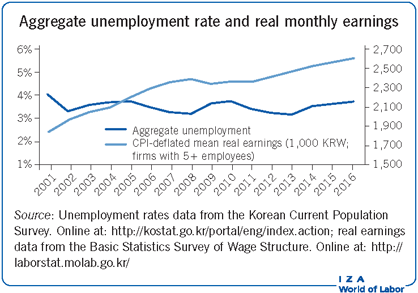Elevator pitch
South Korea has boasted one of the world's most successful economies since the end of World War II. The South Korean labor market has recovered quickly from the depths of the Asian crisis in 1998, and has since remained surprisingly sound and stable. The unemployment rate has remained relatively low, and average real earnings have steadily increased. The South Korean labor market was resilient in the wake of the global financial crisis. However, there are issues that require attention, including high earnings inequality, an aging labor force, increasing part-time jobs, and rising youth unemployment rates.

Key findings
Pros
Unemployment has been low and stable, even during the global financial crisis.
Labor force participation for both men and women has been quite steady, and there is no significant gender difference in unemployment.
Average worker real earnings have risen since the immediate recovery from the 1998 Asian crisis.
South Korea is one of the OECD countries with the longest working hours, but weekly working hours have fallen considerably in recent years.
The gender gap in educational achievement has closed, and the share of college-educated workers is high.
Cons
Youth unemployment is increasing and much higher than the adult average.
The female labor force participation rate is far lower than for men, and the gap is closing very slowly; the gender earnings gap is also large.
The share of part-time workers has increased and is higher in small-sized establishments.
Earnings inequality has increased in the lower part of the earnings distribution, due in large part to the decrease in relative earnings of small firm workers.
The share of part-time workers has increased and is higher in small-sized establishments.
The labor force is getting older; labor shortage and skill mismatch are potential problems in the future.